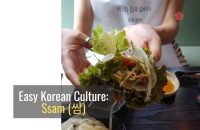Ever wonder about those small dishes Koreans eat?
This blog post covers all you need to know about banchan including:
- the best types
- why they’re unique
- banchan do’s and don’ts
Banchan make any meal a joy.
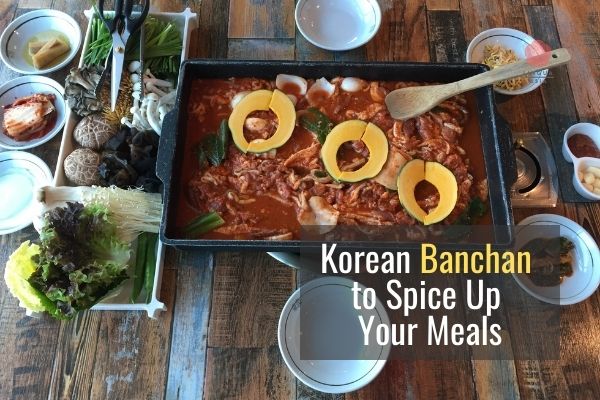
Key Takeaways
- Banchan means small side dishes that are served either before or with your meal in Korean cuisine.
- Kimchi isn’t considered banchan since it’s a standard condiment.
- You can get banchan refilled for free at a restaurant.
Banchan are like uninvited party guests who turn out to be really cool. Once you’ve had them around, you’ll wish they showed up everywhere.
Let’s explore the different types of Korean banchan and how to prepare them.
What are banchan?
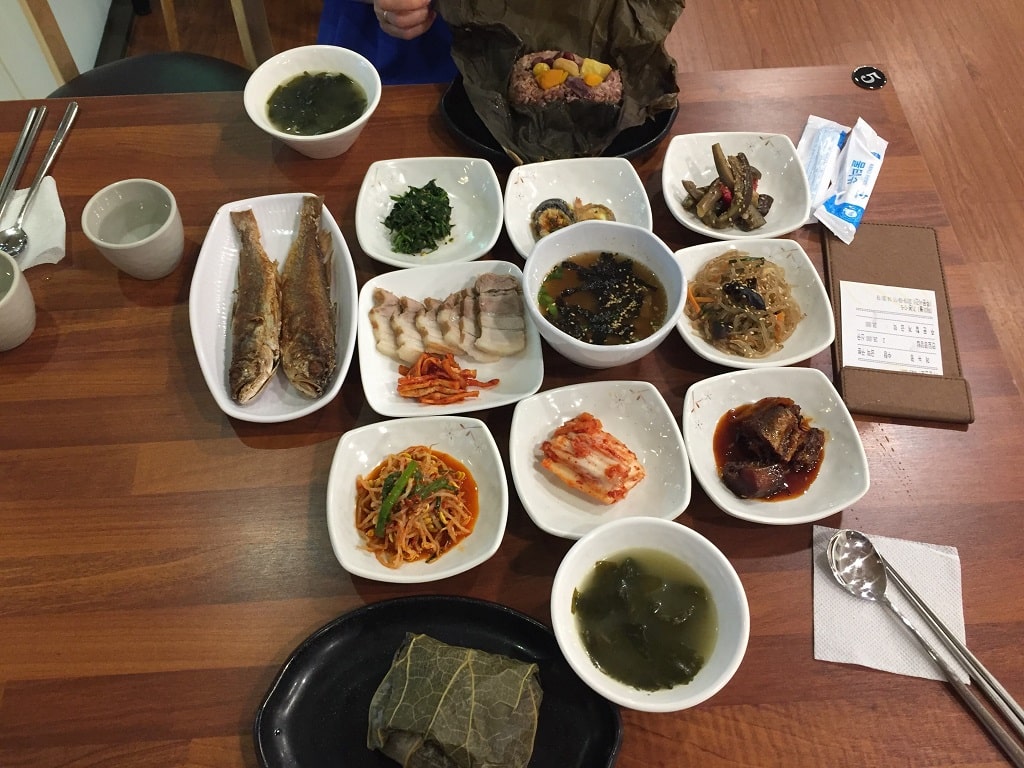
Banchan (반찬) cover a lot of ground in Korean cuisine. The word itself literally means “half serving” in Korean. They’re small side dishes that are served either before or with your meal in Korean cuisine.
When Koreans mention banchan, they mean every dish except rice, kimchi and soup.
Banchan include leafy vegetables, beef, pork, fish and savory pancakes.
Hidden Culture
Surprisingly, Kimchi isn’t considered banchan since it’s basically a standard condiment.
But, main dishes can be considered banchan at times like galbijjim. Don’t worry if it gets confusing!
One sure way to annoy Korean moms, wives or ajumma is complaining about the lack of banchan (Koreans call it 반찬투정 or banchan tujeong).
One thing’s for sure, after you’ve tried banchan, meal time will never be the same.
The origins of banchan in Korea
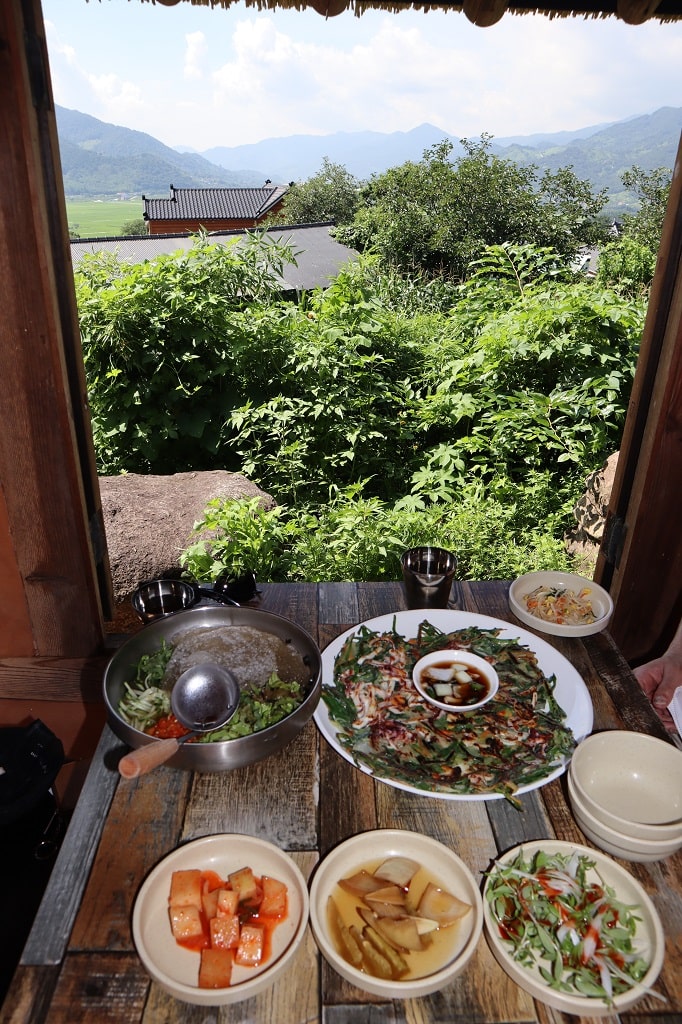
Korean banchan most likely originates from Buddhist influence on Korean dietary practices, including restrictions on meat and alcohol. It also affected the type and style of dishes that were offered to deceased ancestors, which in turn led to changes in everyday dishes.
During the three kingdoms period (57 BC to 935 AD) when Buddhism flourished, meat-based offerings were banned in favor of vegetable dishes.
The Mongol invasions ended this ban and meat was back on the menu.
Up until the Joseon dynasty, people ate at their own tables with personal dishes. After the Japanese occupation, food and resources became scarce, so people started sharing dishes.
Over time, banchan evolved to include all types of dishes including seafood, pancakes and grains.
Why Korean banchan is unique
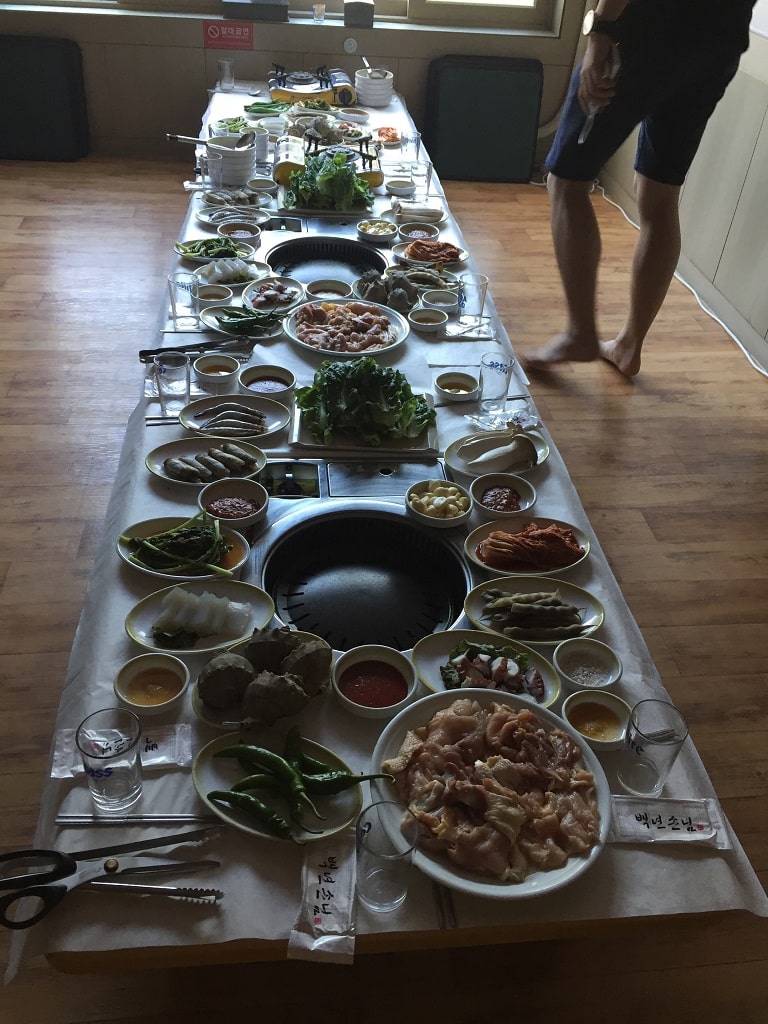
- They’re not quite appetizers but not quite meals. Banchan are like support for the main dish and can be used as a condiment, contrast, complement and palate cleanser.
- They’re super easy to make. Most require just a few ingredients and steps.
- There’s a banchan for everyone no matter what you’re into.
- You can also have them refilled at least once (twice if the server likes you) for free!
- They’re a great way to eat healthy and add variety to your diet.
- Banchan can add some cool flavors and variety to a vegan or vegetarian diet.
- They’re perfect for meal prep, since you can make a large batch and store it for a week.

Types of Korean banchan
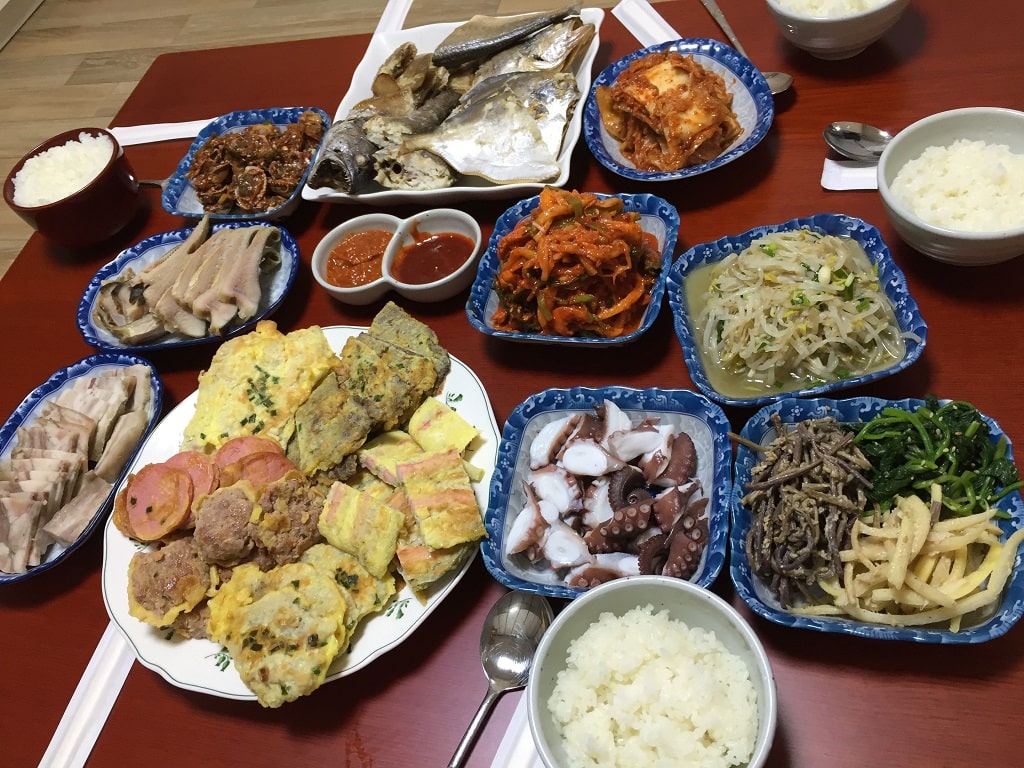
Leafy Banchan
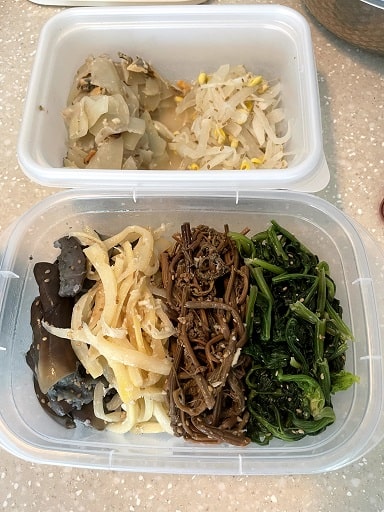
Sigeumchi Namul (시금치나물) – Seasoned Spinach: Common, but with good reason. It’s the tastiest way to eat spinach that doesn’t require cheese or butter.
Minari Namul (미나리나물) – Seasoned watercress : A bitter green herbal dish with amazing health benefits, one of them being hangover prevention.
Chwi Namul (취나물) – Seasoned aster scaber: Don’t let the unappealing English name fool you. This fragrant dish is one of the tastiest vegetable banchan. It’s even better when it’s made by a grandma from Jeolla province.
Root Banchan
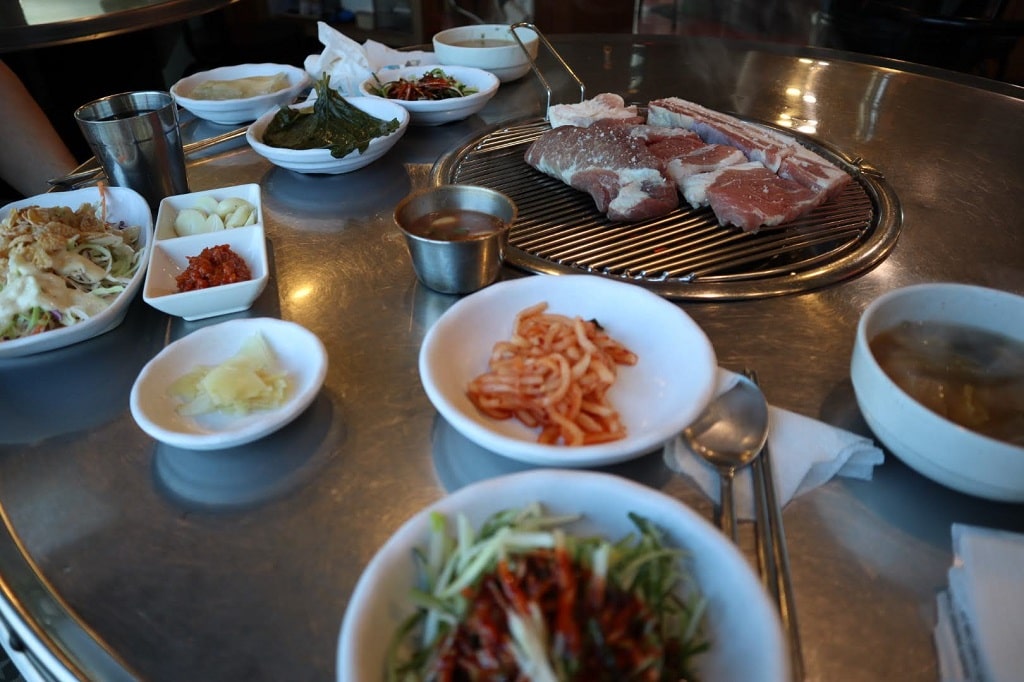
Gamja Jorim (감자조림) – Braised Potatoes: A little naughty since it requires sugar, but so delicious. I always get these refilled once or twice.
Mu Namul (무나물) – Stir-fried Radish: Not the most exciting entry, but works well as a palate cleanser.
Mu Saengchae/Muchae (무생채/무채) – Sweet and Sour Radish Salad: Long julliened white radish with some pop from the sweet vinegar. Very refreshing and goes well with meat.
Squash Banchan
Hobak Bokkeum (호박볶음) – Stir-fried Zucchini: A great way to eat your veggies. Tastes savory and a little sweet.
Mushroom Banchan
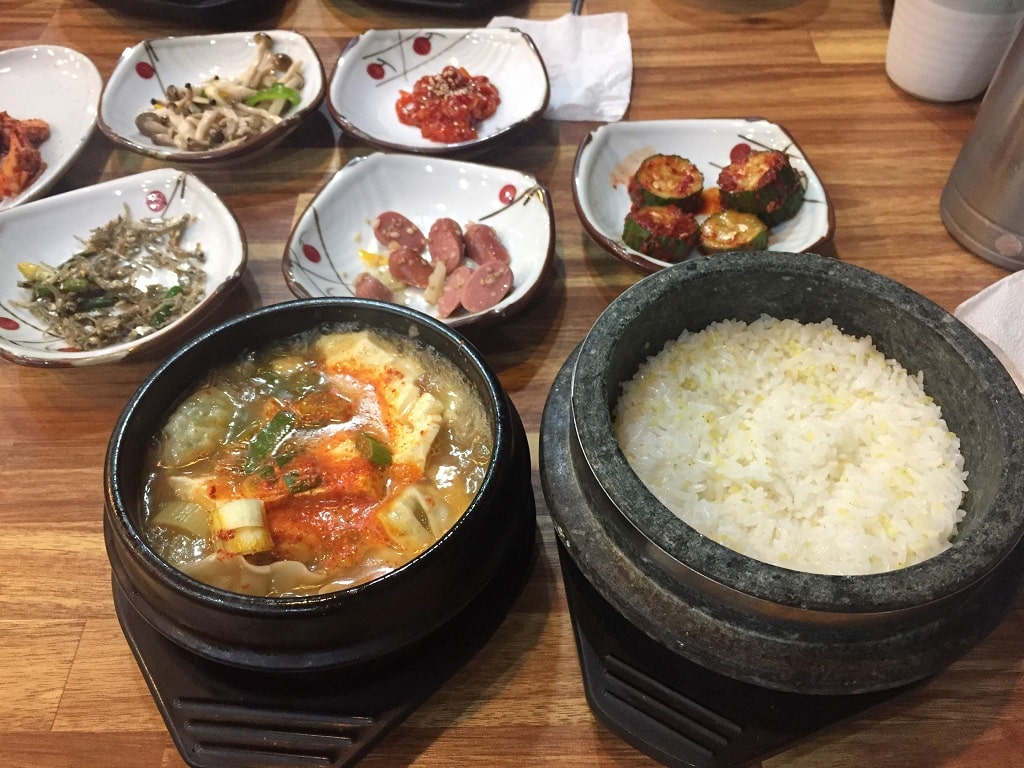
Buseot Bokkeum (버섯볶음) – Stir-fried mushroom: A must if you’re a fan of mushrooms. It comes in a few varieties, but is best with mushrooms from a farmer’s market.
Egg Banchan
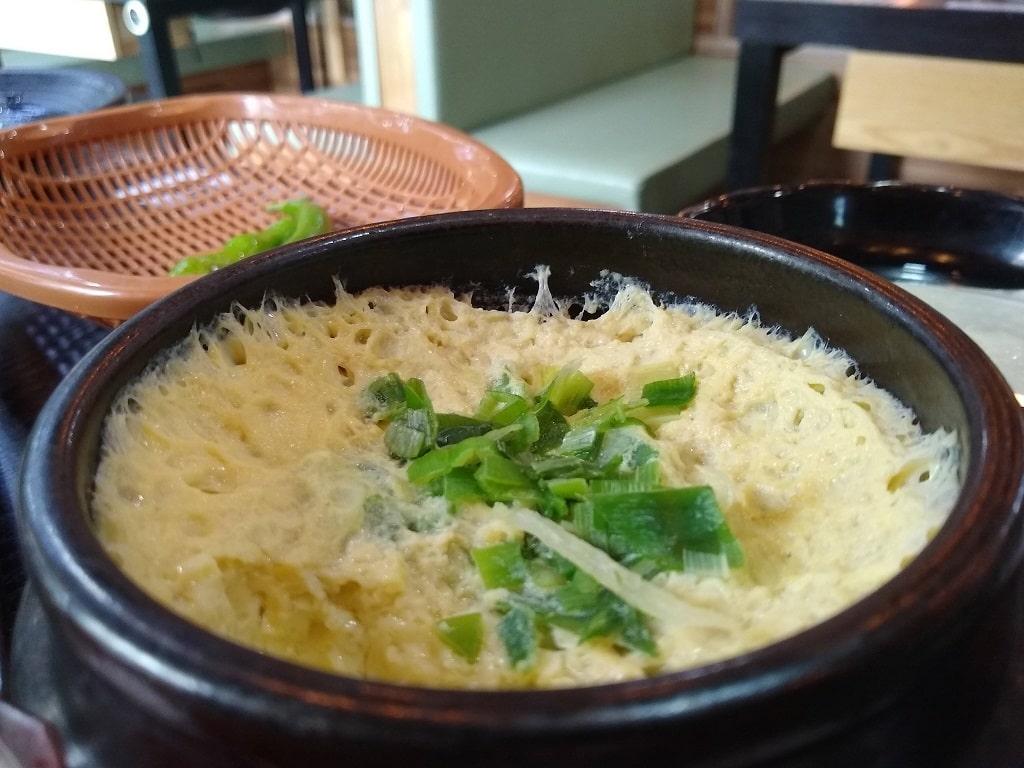
Gyeran Jjim (계란찜) – Steamed eggs: Like a delightful mini-omelet that goes great with everything. It can put you in a trance.
Gyeran Mari (계란말이) – Rolled or folded omelet: You can add ingredients as you like, such as chopped vegetables, gim (dried seaweed) or even cheese. They make great anju (안주 or food with alcohol) as well.
Vegetable Banchan
Gaji Namul (가지나물) – Steamed Eggplants: Delicious, even for people who aren’t fans of eggplant. The toasted sesame oil adds savory goodness and masks the bitterness of the vegetable. (A lot of Korean kids don’t like its mushy texture though.)
Oi Bokkeum (오이볶음) – Stir-fried Cucumbers: Really great with alcohol. These are basically fried pickles that are still healthyish.
Gaji Bokkeum (가지볶음) – Stir-fried Eggplants: If the steamed version is too bland for you, try frying them with some gochujang (red pepper paste).
Jangajji (장아찌) – Vegetable pickles: These salty and slightly sweet vegetables are the perfect complement to any meal.
Sprout Banchan
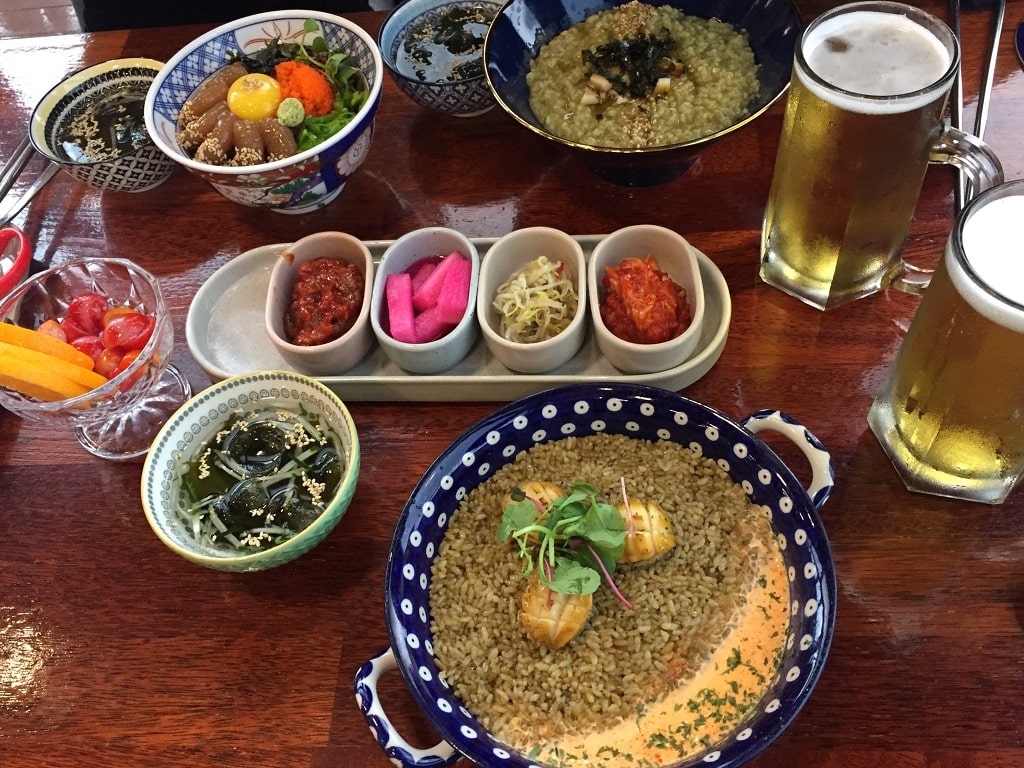
Kongnamul Muchim (콩나물무침) – Seasoned Soybean Sprouts: These crunchy veggies with toasted sesame oil will change the way you look at sprouts. They’re also a must on bibimbap.
Sukju Namul Muchim (숙주나물무침) – Seasoned Bean Sprouts: A great way to eat bean sprouts. Once you’ve had these, you’ll start craving their leafy goodness.
Seafood Banchan
Mareun Saewoo Bokkeum (마른새우볶음) – Sauteed fried shrimp: These tiny shrimp are dried first then fried with gochujang. They’re an excellent source of calcium too!
Myulchi Bokkeum (멸치볶음) – Sauteed fried tiny anchovy: Another common seafood banchan with loads of calcium that Korean moms make often for their kids.
Tofu Banchan
Dubu Jorim (두부조림) – Soy braised tofu: Tofu banchan that will make you forget that you’re eating healthy. I personally eat this one whenever I get a chance.
Meat Banchan
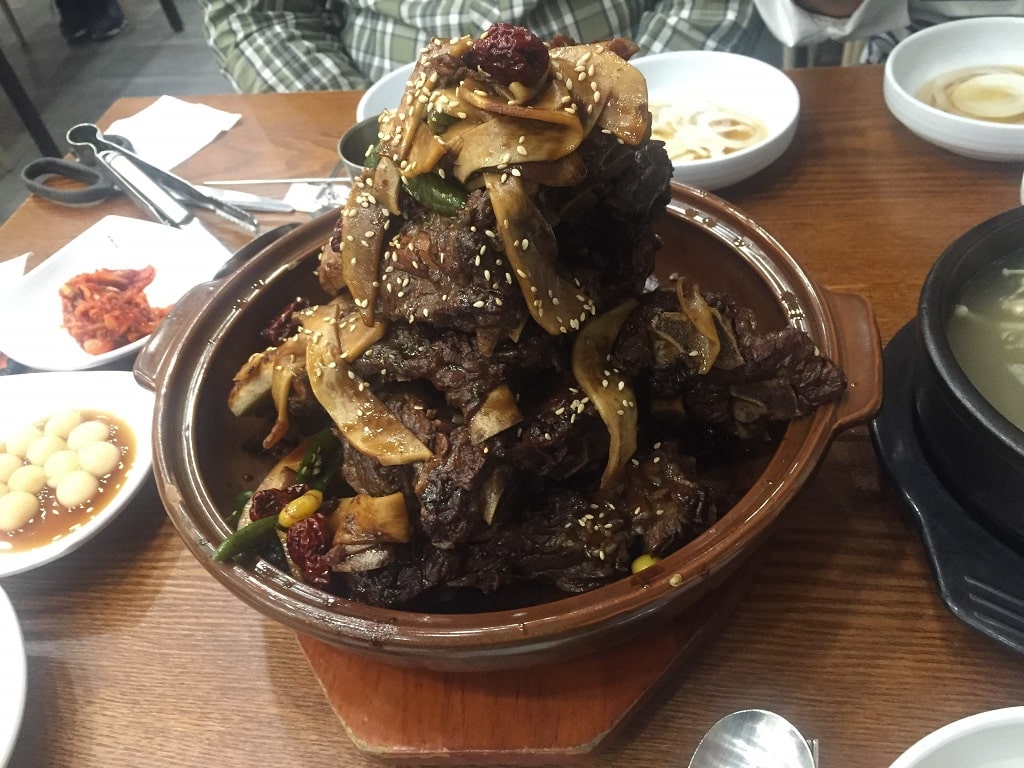
Jangjorim (장조림) – Soy braised beef: A salty and slightly sweet banchan that’s perfect for vegetable dishes. It’s a sure-fire way to make sure no one complains about the banchan selection.
Pancake Banchan
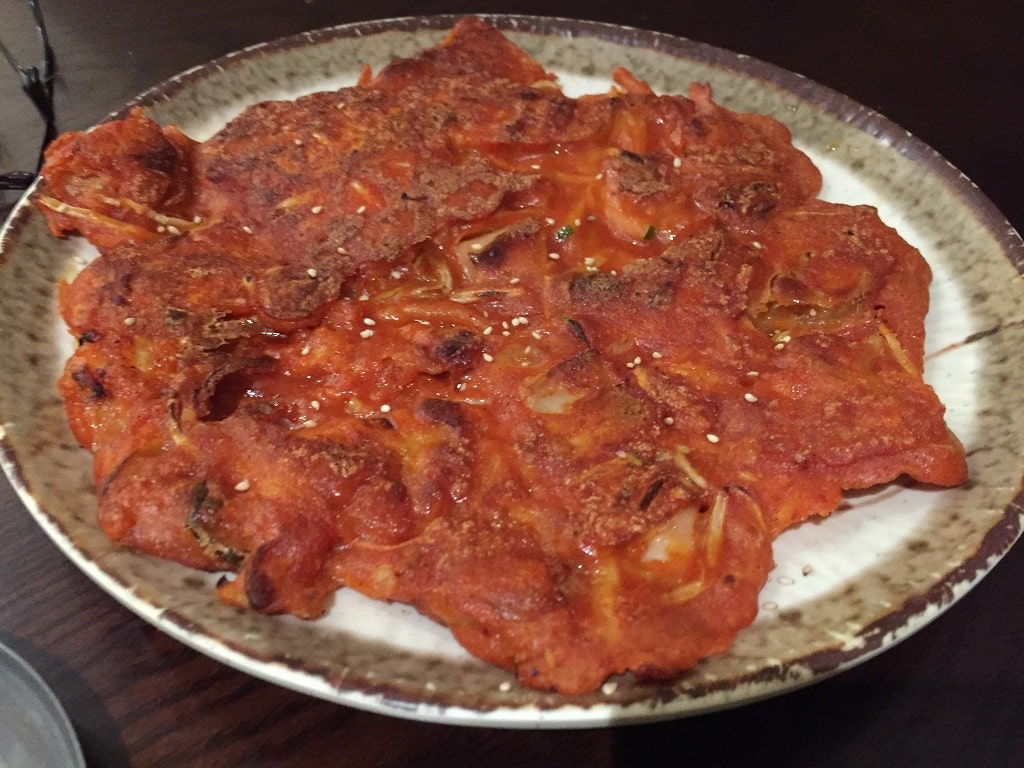
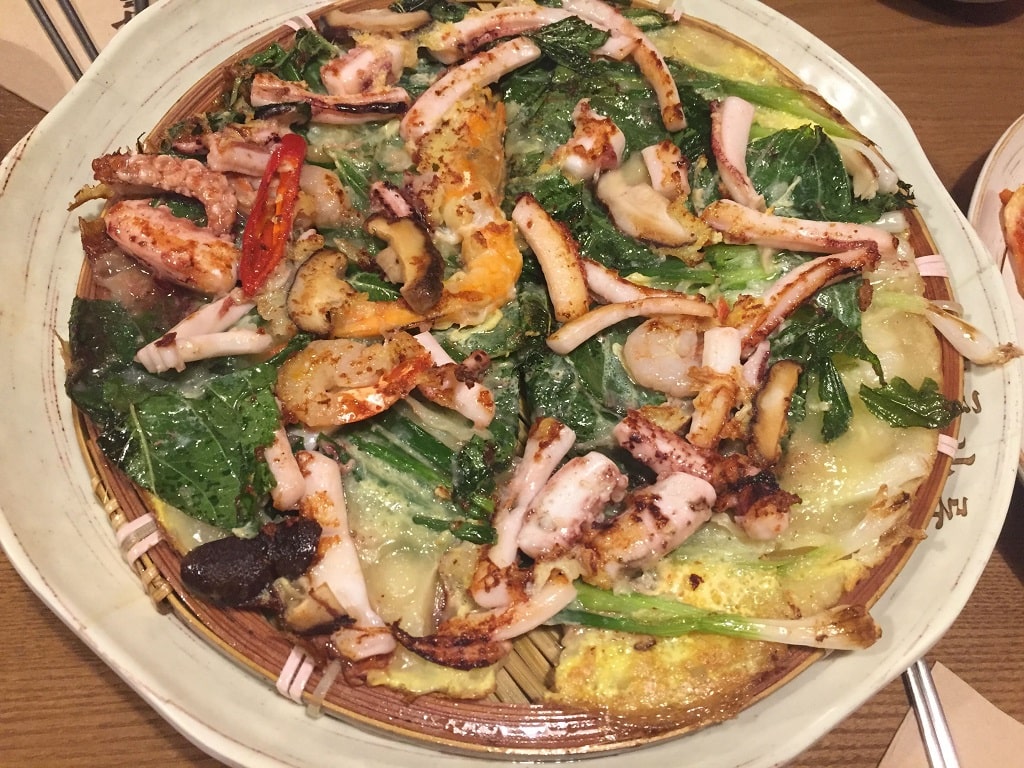
Kimchi Jeon (김치전) – Savory Kimchi pancakes: The perfect rainy-day treat. It has a lovely sour note that’s hard to get enough of.
Pajeon (파전) – Green onion pancakes: A more toned down version of jeon compared to the previous entry, but still packs a lot of flavor. Koreans normally add seafood (haemul or 해물) to pajeon. This banchan goes well with pretty much everything, especially makgeoli (막걸리).
Gamjajeon (감자전) – Potato pancakes: Exactly how it sounds but with a Korean twist. Gamjajeon also compliments any dish.

How to make and enjoy Korean banchan at home
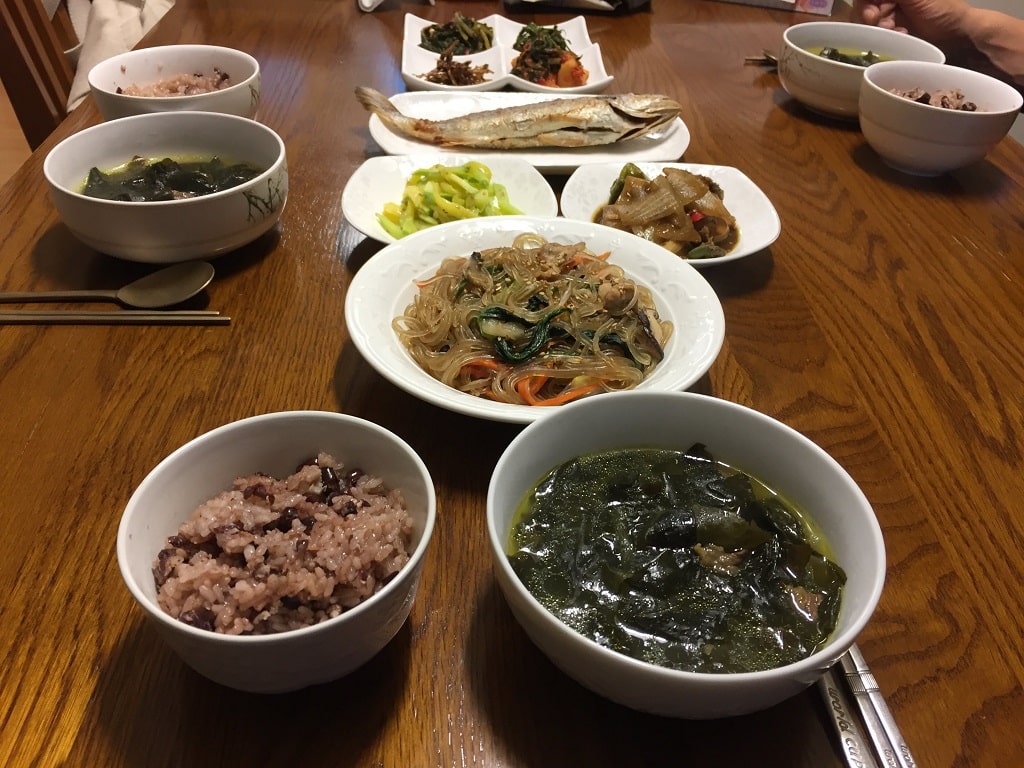
Banchan is easier to make than you’d think. But it takes a few tries to get the ratios the way you like. Ajumma don’t usually measure ingredients and cook by feel instead.
Here are simplified recipes for each type of banchan.
Namul
Ingredients
- 1 bunch or around 6 to 8 oz of vegetable
- 2 teaspoons salt, plus more to taste
- 1 scallion (chopped)
- 1/2 teaspoon minced garlic (Koreans put a lot more like a tablespoon or handful, but you can start off with a little)
- 1/2 teaspoon toasted sesame oil (must be toasted sesame oil to have that Korean flavor)
- 1 teaspoon sesame seeds
- 2 teaspoon soy sauce
- 1 teaspoon sugar
Steps
- Boil 6 cups of water and two teaspoons of salt
- Blanch thin vegetables for 30 seconds or until wilted or boil thicker vegetables until cooked
- Shock vegetables in cold water for 30 seconds or until wilted
- Drain vegetables and squeeze to remove excess water
- Cut vegetables in 2 to 3-inch lengths
- Mix all ingredients in a bowl
Bokkeum
Ingredients
- 10 to 12 oz of meat or vegetable
- 2 teaspoons saewoojeot (salted shrimp) or salt to taste or fish sauce
- 1 teaspoon minced garlic cloves
- 1 scallion finely chopped
- 1 teaspoon toasted sesame oil (must be toasted sesame oil to have that Korean flavor)
- 1 teaspoon sesame seeds (preferably crushed)
Steps
- Cut meat or vegetable into ¼ to ⅓ – inch thick slices
- Fry in pan with oil and saewoojeot
- Add 2 tablespoons of water and rest of ingredients
- Cook until vegetables are soft or meat is done. (make sure not to overcook!)
Jorim
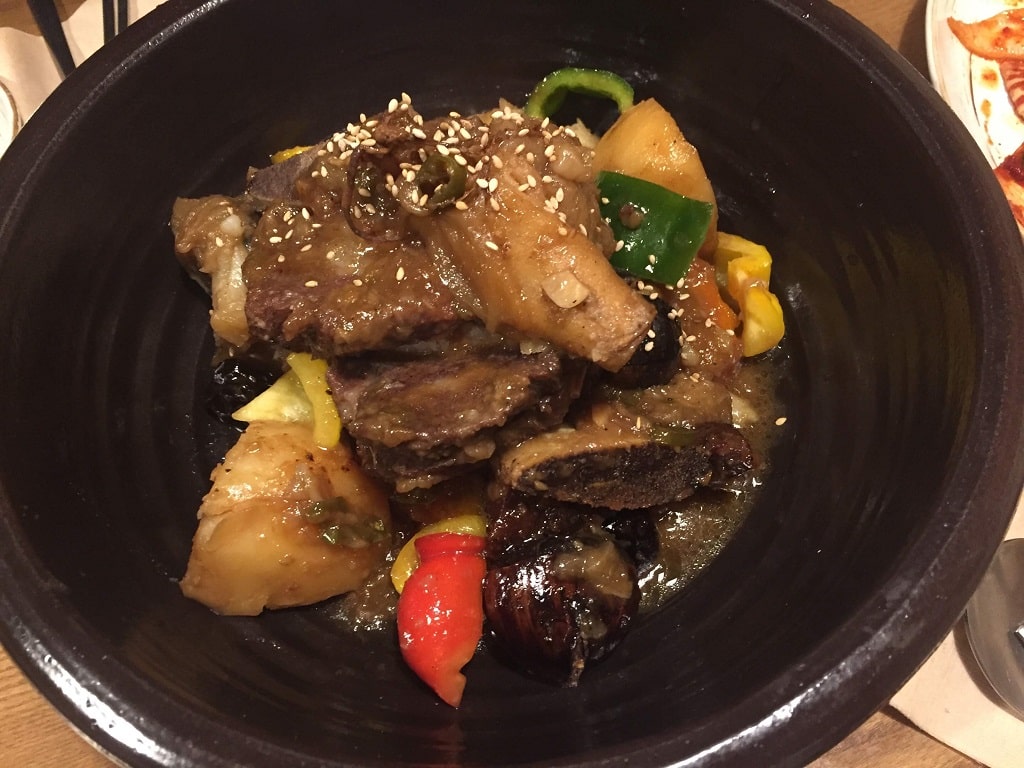
Main ingredients
- 1.5 pounds of vegetable or meat
- 1 carrot (about 3 ounces)
- 1 potato (about 3 ounces)
- 6 garlic cloves
- 2 to 3 green chili peppers (or ½ green bell pepper)
- ¼ medium onion
- 1 tablespoon cooking oil
Sauce ingredients
- 3 tablespoons soy sauce (or 2 T soy sauce and 1 T gochujang if you want some spice)
- 1 tablespoon sugar
- 1 tablespoon rice wine (or mirin) You can omit if unavailable.
- 1 tablespoon corn syrup (or oilgodang)
- 1 teaspoon minced garlic
- pinch of black pepper
- ¾ cup water
- 1 teaspoon toasted sesame oil (must be toasted sesame oil to have that Korean flavor)
- ½ teaspoon roasted sesame seeds
Steps
- Cut meat or vegetable into 1(meat) or 1/2 (vegetables) inch cubes.
- Bring 8 cups of water in a covered pot and the main ingredients minus the meat or vegetable to a boil. Boil for 5 more minutes on medium high heat.
- Add meat or vegetable and boil for 30 minutes while removing scum.
- Strain pot while leaving 2.5 cups of broth (you can use the leftover broth later!) and add sauce ingredients and boil 20 more minutes.
- Cool before refrigerating.
Jeon

Ingredients
- ½ pound vegetable, chopped into small pieces, (plus 2 tablespoons of the brine for Kimchi jeon)
- 3 scallions, chopped
- ½ teaspoon sugar
- ½ cup all-purpose flour
- ½ cup water
- 4 tablespoons vegetable oil
Steps
- Combine ingredients minus oil in a medium bowl and mix well with a spoon.
- Heat a 12-inch nonstick skillet.
- Add 2 tablespoons of the vegetable oil and swirl to coat bottom of pan.
- Pour batter into pan and spread it with a spatula to make a large circle
- Cook until bottom is golden brown and crispy for 3 to 5 minutes, then carefully turn the pancake over. Add 2 tablespoons of oil around the edges of skillet, then allow oil to run underneath.
- Cook until bottom of pancake is crisp for 3 to 5 minutes, then flip one more time and cook for another minute.
- Slide onto a large serving platter and serve immediately.
Gyeran Jjim
Ingredients
- 4 large eggs
- 1 cup anchovy broth (or water or dashima broth)
- 1-½ teaspoons salted shrimp (saewoojeot) or ¾ teaspoon salt (or fish sauce) or chicken stock
- 2 tablespoons chopped scallion
Steps
- Beat eggs well in a bowl (Run mixture through a sieve for a smooth liquid consistency for even better results).
- In lightly oiled small stone/ceramic pot, mix eggs well with anchovy broth or water, then chicken stock or salted shrimp (saewoojeot).
- Cover, and simmer over medium low heat on the stove for about 7 minutes. The egg mixture should still be runny in the middle at this point.
- Gently stir eggs in a circling motion with a spoon. Reduce the heat to low. Add scallions, cover, and simmer for 2 to 3 minutes until mixture is set.
Insider Tip
You can cook gyeran jjim in a microwave to make things easier.
Korean banchan etiquette
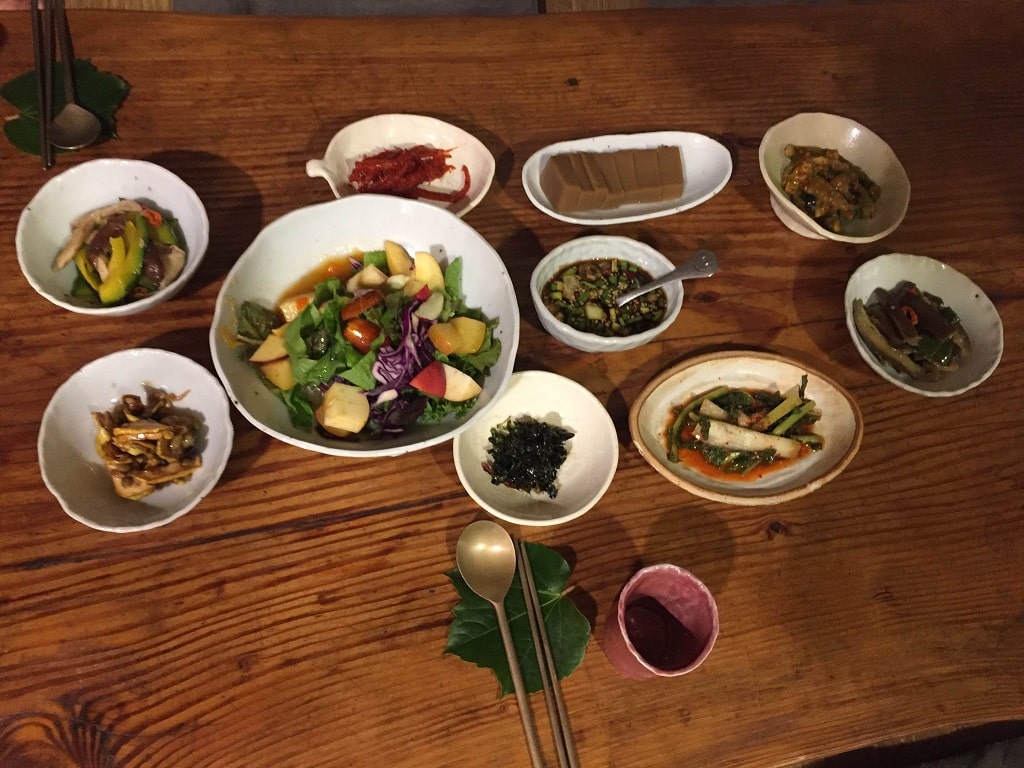
Here are a few do’s and don’ts when it comes to banchan.
- Enjoy them wholeheartedly.
- You can dish them up first if you have a small plate in front of you (앞접시 or apjeopshi). Otherwise, it’s OK to eat them directly from their serving dishes.
- Don’t eat them all at once when you’re with company. Try a few bites from each of them.
- Don’t stir or poke around with your chopsticks. Think of it like a claw machine game. Whatever your chopstick reaches first gets picked up.
- Don’t eat all the obviously favorite banchan at once. You’ll know with nunchi.
- Feel free to ask for refills once, and twice if you’re really hungry or a regular customer. It also helps to say that they’re very delicious with a smile.
- Restaurants might have a “self” area where you can dish up more banchan to your heart’s content.
FAQ
How many types of banchan are there?
As many as there are Korean dishes. No one’s sure but there are hundreds.
Are banchan healthy?
The majority of banchan are but some have some sugar added. As a rule of thumb, if it tastes sweet, it probably isn’t the healthy kind.
Are all banchan spicy?
Not all. There are many banchan that are a combination of salty, sweet and savory. There’s a banchan for everyone!
Which region in Korea has the best banchan?
Jeolla province has the best banchan in Korea. They even serve 100 banchan at upscale hanjeongshik restaurants.
How long does banchan last?
Banchan can last for at least a week in a tupperware container.
Is kimchi considered banchan?
Surprisingly, it is not. Kimchi is so ubiquitous in Korean meals, that it’s considered a standard condiment.
Is it rude to ask for more banchan?
Not the first time, but if you keep asking you might be met with some resistance from a grumpy ajumma.

Subscribe for
exclusive info on Korea
Did we miss anything?
Koreans consider everything that’s not soup, rice or kimchi banchan.
Let us know your favorite banchan in the comments!




